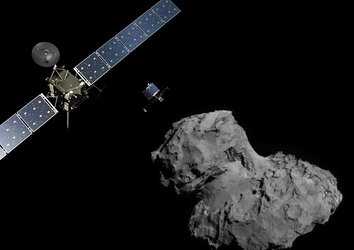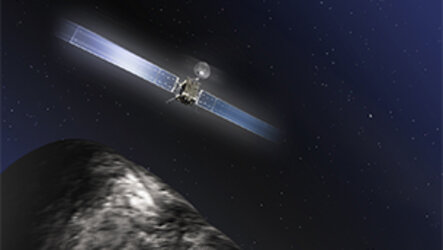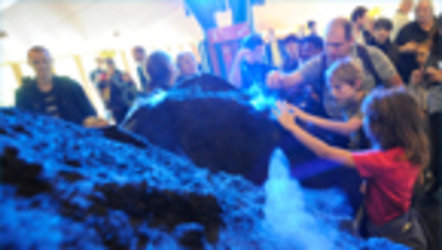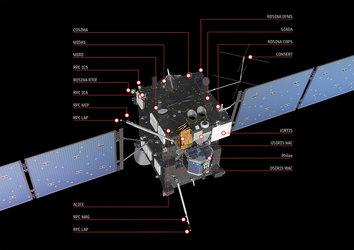The competition winners who helped us wake up Rosetta
We asked you to help us wake up Rosetta from 31 months of deep-space hibernation in a fun video shout-out contest. With over 200 entries and 75 000 votes, you certainly succeeded!
The rules were simple: take out your mobile phone and record a ‘selfie’ of you shouting “Wake up, Rosetta!” But you were far more creative than that…
We were truly impressed by the effort that all of you put into your videos, from getting your pets, friends and families involved and constructing fantastic model Rosetta spacecraft, to storyboarding brilliant stop-motion animations with Lego, and writing entire songs and choreographing dance routines for dozens or even hundreds of passionate Rosetta fans.
We were also delighted to receive entries not only from across Europe, but from all over the world, including Colombia, Canada, Africa and Hong Kong.
In total, we received 218 entries, including a few from our friends – Chris Hadfield, Bill Nye, our partners in the German and French space agencies, our Director General and our astronauts, with many of the institutes involved in the Rosetta mission also supporting the campaign. We even received video messages from the singer Tasmin Archer – well known for her song ‘Sleeping Satellite’– and a band called ‘Rosetta’.
Although we encouraged short videos, many of you produced excellent longer contributions. Many entrants also campaigned hard to collect thousands of votes on their videos.
Visitors to the competition page could vote for their favourite videos, which ranked the top ten submissions.
Congratulations to the following entrants!
10. Gerald Darroles, Canada (2355 votes)
9. High School Veno Pilon, Slovenija (2463 votes)
8. Michela Ponzio, Italy (2538 votes)
7. Bruno Correia Da Costa, Portugal (2654 votes)
6. Kristof Verniers, Belgium (2690 votes)
5. Alessio Chiama, Italy (2760)
4. Peñaluenga Public School, Spain (2925 votes)
3. 26th & 29th Primary Schools of Acharnes Olympic Village, Greece (5791 votes)
2. Józef Dobrowolski, Poland (9092 votes)
1. Ellinogermaniki Agogi Primary School, Greece (10508 votes)
Video mashup highlighting some of the excellent entries
Although not eligible to receive a prize according to the published rules, we would nevertheless like to make special mention of Leopoldo Gamba of Colombia, whose video received 2528 votes.
Each of the top 10 videos will be transmitted into space via one of ESA’s 35 m-diameter deep-space tracking dishes in a few weeks’ time. Each person or team who submitted a top ten video will also receive a gift bag containing a selection of ESA-branded souvenirs.
Top prize winners
The two entries with the top votes also impressed the ESA judges so much that we are delighted to invite Józef Dobrowolski from Poland, and a teacher and student from Ellinogermaniki Primary School, Greece, to our control centre in Darmstadt, Germany, for the VIP event celebrating the first-ever landing on a comet, in November. Both winning entries are shown below.
But to us everyone is a winner! To say thank you, we have put together a short video comprising clips from many of your submissions (see above).
We would also like to invite participants to download a pair of social media images to add to your Facebook page to tell the world: “I helped wake up Rosetta”.
There is also a complete new set of Rosetta 'Hello, World!' icons available for PC/Mac, tablets, mobile, Facebook, Twitter, G+ and other formats.
Now that the Rosetta spacecraft is awake, the spacecraft will continue its journey towards comet 67P/Churyumov–Gerasimenko. In August it will become the first spacecraft to rendezvous with a comet. In November, Rosetta will deploy its Philae lander to the comet’s surface – the first time landing on a comet has ever been attempted. Rosetta will also be the first spacecraft to escort a comet as it draws closer to the Sun in 2015.
Comets are time capsules containing primitive material left over from the epoch when the Sun and its planets formed. By studying the gas, dust, structure of the nucleus and organic materials associated with the comet, via both remote and in-situ observations, Rosetta should become the key to unlocking the history and evolution of our Solar System, as well as answering questions regarding the origin of Earth’s water and perhaps even life.
We look forward to sharing the next stage of the adventure with you. For regular mission status updates, please follow our Rosetta blog. You can also connect with us on the Rosetta Mission Facebook page and the @ESA_Rosetta twitter account.
More information
Rosetta is an ESA mission with contributions from its member states and NASA. Rosetta’s Philae lander is provided by a consortium led by DLR, MPS, CNES and ASI.








